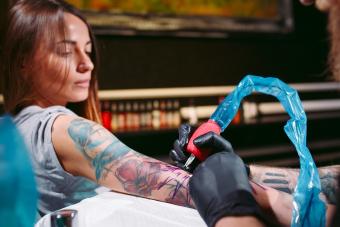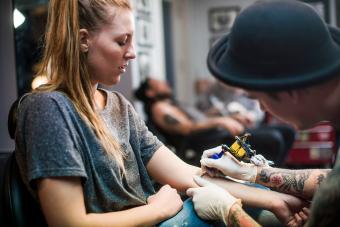
Does getting a tattoo hurt? Most people would say "yes, they do." However, pain levels differ for everyone. Your genes and your overall health have a lot to do with how much it will hurt to get inked. Where you decide to get your tattoo can also make a difference in how much pain you experience. Before you make a decision about if or where you will get a tattoo, it might be helpful to learn more about how and why tattoos hurt.
Personal Factors That Influence Tattoo Pain
The pain that goes along with getting a tattoo is often a reason why some people decide to forego body art. If you are determined to get inked, it can be helpful to understand the factors involved with tattoo pain.
Unfortunately, however, measuring the pain involved in getting tattoos is not an exact science. For one person, a lower back tattoo might be the most painful tattoo, while for another person it may be the one that bothered them the least.
Each person is different, and there are a few personal factors that can help you gauge how much getting a tattoo will hurt you, according to Health Psychology Open.
Bruising
Do you bruise easily? A tendency to bruise indicates a loss of fatty tissue, states the Mayo Clinic If so, tattoos in areas with thinner skin might affect you more than someone else.
Pain Tolerance
When you hurt yourself (stubbing your toe, for example), how would you rank the pain? If you would rank the pain low for most minor injuries, tattoos might not hurt as much for you as for other people. And you don't have control over this. The American Academy of Neurology points out that pain tolerance is often determined by genetic factors.
Placement
Are you getting a tattoo in a "fleshy" area? Many tattoo veterans will tell you that tattoos in areas with a lot of skin and fat tend to hurt less than tattoos in areas with less padding or over bones.
Sensitive Areas
Are there any parts of your body that are especially sensitive? If there are, you might not want to get a tattoo there.
Tattoo Placement and Pain
When yuo get a tatoo, you are creating a wound in the skin with a needle. However, outside of personal factors, placement is something you can control when it comes to pain. There is no clear scientific evidence or medical studies that provide guidance regarding the most or least painful place to get a tattoo, but anecdotal reports suggest that there are more painful and less painful places to get inked.
Least Painful Places to Get a Tattoo
Places likely to hurt the least are those with adequate "padding." These areas are generally fleshy areas with less tightly packed nerves than other areas of the body. The upper arm and outer or top part of the thigh are especially painless for many because they are large expanses of skin without a lot of dense nerve endings. Lower risk for pain places are:
- Outer and top area of the thigh
- Outer calf
- Upper arm
- Upper back
Moderately Painful Tattoo Areas
Repeat needle injections in some areas of the body are no problem for people with high pain thresholds, not so great for others. It's personal. These places get mixed results when it comes to pain and discomfort.
- Ankle
- Inner arm
- Inner thigh
- Lower back
Most Painful Areas for Tattoos
There are some areas of the body that are likely to hurt more than others no matter how high your pain threshold is. Any section of skin with tightly packed nerves or a thin layer of flesh over bone is extra-sensitive. Any "connecting" area - such as a joint or the armpit - has important nerves, like the axillary nerve in armpit, and is, therefore, more likely to transmit pain.
- Any joints (such as the kneecap or elbow)
- Armpit area
- Fingers (and hands)
- Groin area
- Top of the foot
- Ribs, chest, and sternum
- Wrist
Further Considerations With Tattoo Pain
When considering pain, placement is important. But if you really want a fish on your wrist, go for it. The pain is only there for a moment in time, and the ink is forever. However, if you are really worried about pain, you have a few further considerations.
Tattoo Size
In general, fleshy areas don't hurt as much as thin-skinned body parts, but the size of the tattoo is also important in these areas. A 40-minute tattoo session for a one-inch tattoo on your lower back is a breeze compared to getting a seven-hour backpiece. Simply because the healing process starts to take place. As the area gets inflamed and your body's defense starts working, tattooing becomes more painful. Additionally, some people notice that the outlining process of the tattoo is the worst, while the fill-in work is minimally painful. It just depends on the person.
Anxiety Level
If this is your first tattoo, you're going to be amped up. However, pain and anxiety are related, according to Stanford Medicine. Stress and anxiety can be a problem when you have chronic pain, but they can also make a tattoo more painful. When you are tensed up, the pain of the needle can seem more painful than it is. Therefore, you might want to try some relaxation and breathing techniques before and in the chair.
Personal Awareness
Know yourself. If you have a high pain threshold, getting inked may seem like a slight annoyance. However, the pain could be severe if you are more sensitive. Talk it out with your tattoo artist, who has experience with both placement and pain tolerance. Then give the whole decision some serious thought. If you're wavering, remember that the pain of getting a tattoo is only temporary - the pleasure you get from that tattoo will last far longer. You can also talk to your artist about pain relieving techniques and creams.







